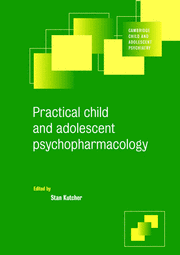Book contents
- Frontmatter
- Contents
- List of contributors
- Preface and acknowledgements
- 1 Child and adolescent psychopharmacology at the turn of the millennium
- 2 Developmental psychopharmacology
- 3 Clinical aspects of child and adolescent psychopharmacology
- 4 Depression
- 5 Bipolar mood disorders: diagnosis, etiology, and treatment
- 6 Schizophrenia and related psychoses
- 7 Obsessive–compulsive disorder
- 8 Anxiety disorders
- 9 Attention-deficit/hyperactivity disorder
- 10 Pervasive development disorder
- 11 Aggressive behavior
- 12 Adolescent substance use disorder
- 13 Tic disorders and Tourette's syndrome
- 14 Eating disorders and related disturbances
- 15 Medical psychiatric conditions
- Index
1 - Child and adolescent psychopharmacology at the turn of the millennium
Published online by Cambridge University Press: 31 August 2009
- Frontmatter
- Contents
- List of contributors
- Preface and acknowledgements
- 1 Child and adolescent psychopharmacology at the turn of the millennium
- 2 Developmental psychopharmacology
- 3 Clinical aspects of child and adolescent psychopharmacology
- 4 Depression
- 5 Bipolar mood disorders: diagnosis, etiology, and treatment
- 6 Schizophrenia and related psychoses
- 7 Obsessive–compulsive disorder
- 8 Anxiety disorders
- 9 Attention-deficit/hyperactivity disorder
- 10 Pervasive development disorder
- 11 Aggressive behavior
- 12 Adolescent substance use disorder
- 13 Tic disorders and Tourette's syndrome
- 14 Eating disorders and related disturbances
- 15 Medical psychiatric conditions
- Index
Summary
Child and adolescent psychopharmacology is a leading edge of pediatric psychiatry and is rapidly growing. It has not always been this way.
Child and adolescent psychopharmacology essentially began in 1937, when Bradley reported that some children with behavior disorders showed a seemingly paradoxical improvement during treatment with racemic amphetamine (Benzedrine®), which he had exploratorily used to treat 30 mostly preadolescent children in a residential treatment facility (Bradley, 1937). For over 60 years, psychostimulant treatment has basically remained unchanged. The characteristics of stimulant-responsive children have been studied and refined over the decades, and (what is currently called) attention-deficit/hyperactivity disorder (ADHD) has become the psychiatric model or prototype disorder for the medication treatment of children.
The prototype treatment: psychostimulants for ADHD
Throughout its existence, psychostimulant treatment has also been the prototype treatment used to express uneasiness about children receiving psychiatric medications. Although fully established scientifically, at least as much as antibiotic treatment, psychostimulant treatment is still controversial in some quarters. Concerns include trepidation about the inappropriate management of children in schools and homes, chemical control of children's minds and behaviours, poisoning of children's bodies, excessive dosing of medication, overmedicalization of child care, departure from the psychoanalytic or child guidance model, inadequate emphasis on the psychosocial themes, inappropriate attempts to find surrogates for adequate staffing and supervision, and social and psychological stigmatization.
Despite such misgivings, Bradley's approach has evolved into the widespread use of various psychostimulants to treat children with ADHD.
Keywords
- Type
- Chapter
- Information
- Practical Child and Adolescent Psychopharmacology , pp. 1 - 37Publisher: Cambridge University PressPrint publication year: 2002
- 1
- Cited by



